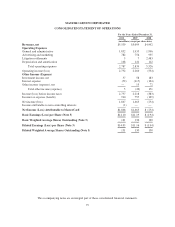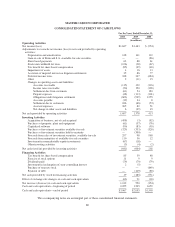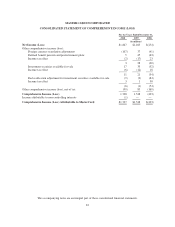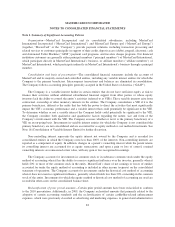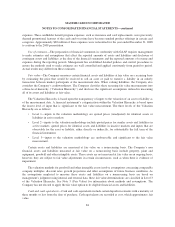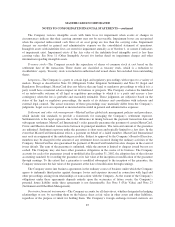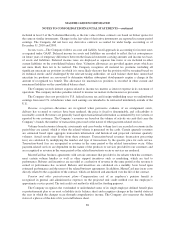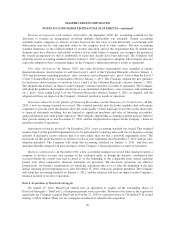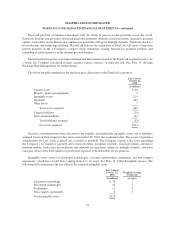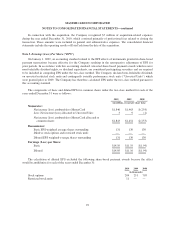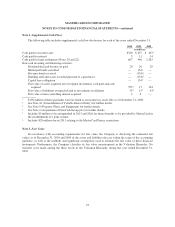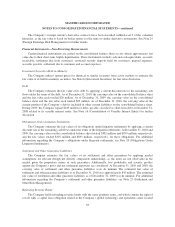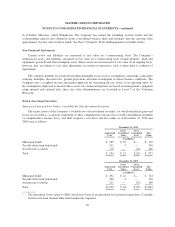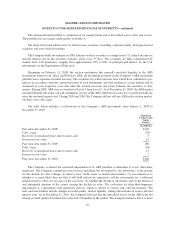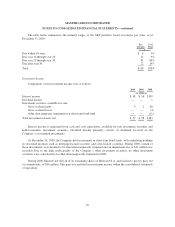MasterCard 2010 Annual Report Download - page 99
Download and view the complete annual report
Please find page 99 of the 2010 MasterCard annual report below. You can navigate through the pages in the report by either clicking on the pages listed below, or by using the keyword search tool below to find specific information within the annual report.MASTERCARD INCORPORATED
NOTES TO CONSOLIDATED FINANCIAL STATEMENTS—continued
Share based payments—The Company recognizes the fair value of all share-based payments to employees
in its financial statements. The Company uses the straight-line method of attribution for expensing equity awards.
Compensation expense is recorded net of estimated forfeitures. Estimates are adjusted as appropriate. The
Company recognizes a realized tax benefit associated with dividends on certain equity shares and options as an
increase to additional paid-in capital. The benefit is included in the pool of excess tax benefits available to absorb
potential future tax liabilities on share based payment awards.
Advertising expense—The cost of media advertising is expensed when the advertising takes place.
Advertising production costs are expensed as incurred. Promotional items are expensed at the time the
promotional event occurs. Sponsorship costs are recognized over the period of benefit based on the estimated
value of certain events.
Foreign currency translation—The Company’s functional currencies include the U.S. dollar, the euro, the
Brazilian real, the Australian dollar, and the U.K. pound sterling. For foreign currency remeasurement from each
local currency into the appropriate functional currency, monetary assets and liabilities are remeasured to U.S.
dollars using current exchange rates in effect at the balance sheet date. Non-monetary assets and liabilities are
recorded at historical exchange rates, and revenue and expense accounts are remeasured at a weighted average
exchange rate for the period. Resulting exchange gains and losses related to remeasurement are included in
general and administrative expenses in the consolidated statement of operations.
Where a non-U.S. currency is the functional currency, translation from that functional currency to U.S.
dollars is performed for balance sheet accounts using current exchange rates in effect at the balance sheet date
and for revenue and expense accounts using a weighted average exchange rate for the period. Resulting
translation adjustments are reported as a component of other comprehensive income (loss).
Earnings (loss) per share—A new accounting standard related to instruments granted in share-based
payment transactions became effective for the Company on January 1, 2009, resulting in the retrospective
adjustment of earnings per share (“EPS”) for prior periods. See Note 3 (Earnings (Loss) Per Share) for further
detail.
Recent accounting pronouncements
Transfers of financial assets—In June 2009, the accounting standard for transfers and servicing of financial
assets and extinguishments of liabilities was amended. The change eliminates the qualifying special purpose
entity concept, establishes a new unit of account definition that must be met for the transfer of portions of
financial assets to be eligible for sale accounting, clarifies and changes the derecognition criteria for a transfer to
be accounted for as a sale, changes the amount of gain or loss on a transfer of financial assets accounted for as a
sale when beneficial interests are received by the transferor, and requires additional new disclosures. The
Company adopted the new standard upon its effective date of January 1, 2010. The adoption did not have an
impact on the Company’s financial position or results of operations.
Variable interest entities—In June 2009, there was a revision to the accounting standard for the
consolidation of variable interest entities. The revision eliminates the exemption for qualifying special purpose
entities, requires a new qualitative approach for determining whether a reporting entity should consolidate a
variable interest entity, and changes the requirement of when to reassess whether a reporting entity should
consolidate a variable interest entity. During February 2010, the scope of the revised standard was modified to
indefinitely exclude certain entities from the requirement to be assessed for consolidation. The Company adopted
the new standard upon its effective date of January 1, 2010. The adoption did not have an impact on the
Company’s financial position or results of operations.
89


